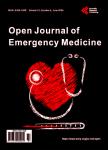Acute Aortic Occlusion in a Critically Ill Adult Presenting to the Emergency Department
Acute Aortic Occlusion in a Critically Ill Adult Presenting to the Emergency Department作者机构:Centre for Accident & Emergency Medicine Nanavati Max Super Specialty Hospital Mumbai India
出 版 物:《Open Journal of Emergency Medicine》 (急诊医学(英文))
年 卷 期:2023年第11卷第4期
页 面:186-191页
学科分类:1002[医学-临床医学] 100201[医学-内科学(含:心血管病、血液病、呼吸系病、消化系病、内分泌与代谢病、肾病、风湿病、传染病)] 10[医学]
主 题:Acute Aortic Occlusion Aortoiliac Occlusive Disease Acute Thrombosis
摘 要:Acute Aortic Occlusion (AAO) is a rare, life-threatening event so far described mainly in small-scale series. The most common causes of AAO are large saddle emboli to the aortic bifurcation, in-situ thrombosis of an atherosclerotic aorta, and occlusion of previous surgical reconstruction. We present the case of a 52-year-old female with rheumatic heart disease, ischemic cardiomyopathy with restricted left ventricular function, atrial fibrillation, and previous cardio-embolic stroke, who was brought to the Emergency Department (ED) with sudden-onset dyspnea and lower backache radiating to both the legs. On arrival at the ED, the patient was electively intubated and mechanically ventilated in view of hypoxia and altered mental status, attributed to respiratory failure secondary to acute cardiogenic pulmonary oedema. The secondary survey revealed absence of bilateral femoral and popliteal artery pulsations. A computed tomography (CT) aortogram showed a complete lumen occlusion thrombus in the infra-renal region of the abdominal aorta at the level of L3-L4 lumbar vertebrae. An emergency embolectomy was performed successfully, following which the patient was started on heparin infusion and managed in the Intensive Care Unit (ICU). In the ICU, she suffered a torsade-cardiac arrest, with return of spontaneous circulation (ROSC) following rapid defibrillation. She was extubated on Day 3. Three weeks later, she was discharged from the hospital. At the time of discharge, she had developed ischemic lumbosacral radiculoplexus neuropathy, for which neuro-rehabilitation was advised. In our case report, we would like to highlight the following key points: 1) The importance of a detailed secondary survey in the Emergency Department (ED). 2) An inter-disciplinary approach to a complex syndrome that ensures the highest probability of a good outcome. .



